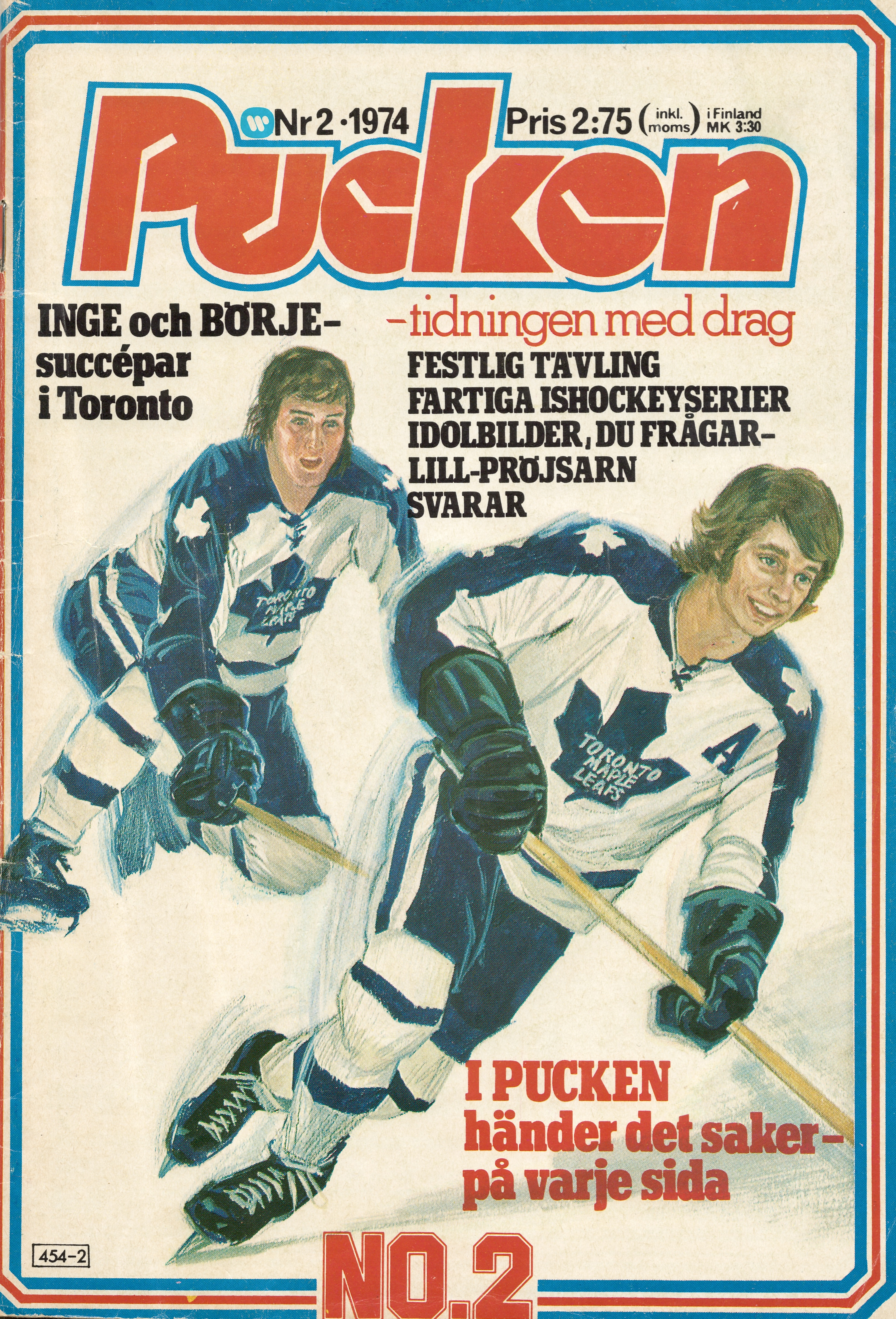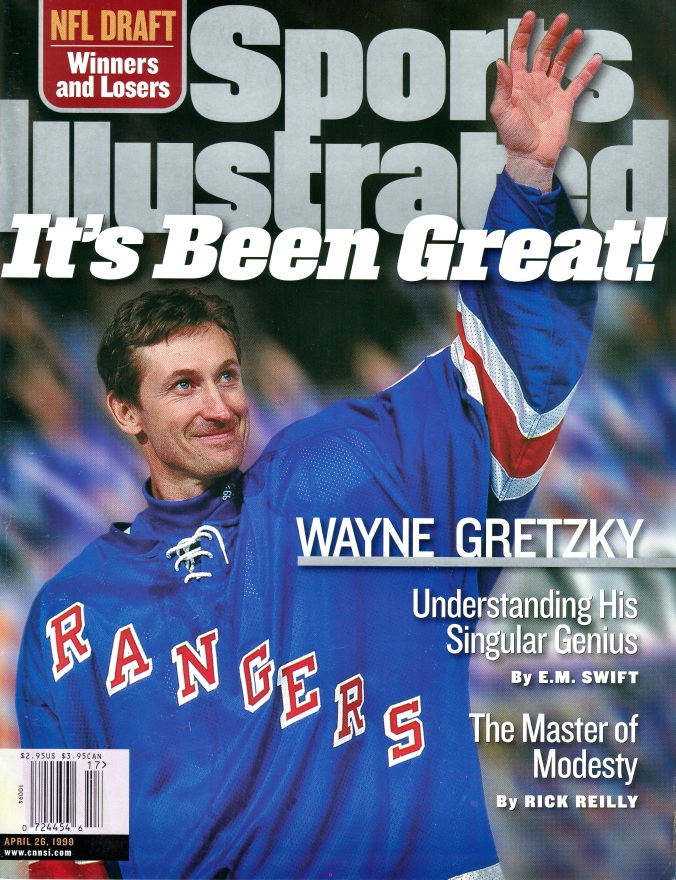
Scandinvasion: A 1974 Swedish hocking magazine marks the export of Salming and Hammarström.
The August news of Börje Salming’s ALS diagnosis was devastating, and the update from his family, earlier this month, was dire: the disease has now robbed Salming, 71, of his ability to speak, and he’s having difficulty eating. “His illness is speeding along very fast,” his wife, Pia, told the Swedish newspaper Expressen. This week, the top men’s and women’s hockey leagues in Sweden announced that on the last weekend of November they will be dedicating Game Day #21 to raising money and awareness for Salming’s new ALS Foundation. Hall-of-Famer Nicklas Lidström is a member of foundation’s board, which you can find here. The ALS Society of Canada is here.
A version of the following post was published in August at TVOntario’s TVO Today.
He was celebrated, in his on-ice heyday, as the best offensive defencemen of his generation not named Bobby Orr. Börje Salming was an efficient defender, too, a shot-blocking, tempo-setting, hard-to-daunt mainstay of the blueline. Majestic is a word that crops up in newspaper accounts dating to his long tenure with the Toronto Maple Leafs. And indeed, in the 1970s, his teammates dubbed him the King of Sweden.
When it comes to marshalling the accolades accorded Salming over the course of his 17-year NHL career, the challenge isn’t in finding a place to begin, it’s in making sure the catalogue encompasses the breadth of his achievement. Salming would, after all, become the first European-born NHLer to play 1,000 games in the league, and the first NHLer born and trained in Europe to be voted into the Hockey Hall of Fame. In late 2016, he was ranked the eighth best player in Leafs’ 100-year history.
None of which, of course, quite quantifies the grace with which he operated under pressure and, in the turbulent NHL of the 1970s, in the face of outright attack. It doesn’t really measure the trailblazing he did, either, for European players in the NHL, as he heralded a new skilled and stylish era for the league, and swept North American hockey into its modern age.
Beyond that legacy, Salming, now 71, remains a beloved Leaf three decades after he last played a game in the blue-and-white. It was in a statement released by the team on August 10 that Salming shared the news that he has been diagnosed with ALS, an incurable progressive disease of the nervous system also known as Lou Gehrig’s disease.
Salming’s diagnosis came after he’d begun experiencing symptoms earlier this year and consulted with doctors at Stockholm’s Karolinska Institutet.
“In an instant,” the former defenceman writes, “everything changed. I do not know how the days ahead will be, but I understand that there will be challenges greater than anything I have ever faced. I also recognize that there is no cure but there are numerous worldwide trials going on and there will be a cure one day. In the meantime, there are treatments available to slow the progression and my family and I will remain positive.”
“Since I started playing ice hockey as a little kid in Kiruna, and throughout my career, I have given it my all. And I will continue to do so.”
As they absorbed the shock of the news, fans, friends, and former teammates united in sympathy and support. “Börje, I am thinking of you in this tough time,” said a latter-day Swedish Hall-of-Fame defenceman, Nicklas Lidström. “Börje is the player I have looked up to my entire career former Toronto captain Mats Sundin told the Stockholm newspaper Sportbladet. “My role model and idol. He has guided me. … I wish him all the strength in the fight against this terrible disease.”
Salming’s hometown, Kiruna, lies far to the north on the Swedish map, in Lapland, 145 kilometres beyond the edge of the Arctic Circle. Built to serve local iron ore mines, it had a population of just over 10,000 in 1951, the year of Salming’s birth. His father worked at the mine, and died there in an accident when Börje was just five.
He and his elder brother Stig might have followed their father’s hardscrabble career path if it hadn’t been for hockey. The Kiruna that they grew up in, as it turns out, turned them into dedicated athletes. Salming has his own theory on how this happened: there was nothing else to do. “It was hard, cold, and dark,” he proposed in Blood, Sweat, and Hockey, the memoir he wrote with Gerhard Karlsson in 1991. “And if you wanted to have fun you had to make it yourself.”
In early outings, on outdoor ice, he was often assigned to tend goal, where he learned not to flinch. “I have never,” he later wrote, “been afraid to throw myself in front of the puck.” If he wasn’t the most talented player on the ice in those early days, he wrote, “my enthusiasm was unmatched.”
“I would have played hockey 24 hours a day if it were possible.”

Game Day #21: At the end of November, Sweden’s top men’s and women’s leagues will dedicate themselves to raising money and awareness for Salming’s ALS foundation.
Salming worked in a mine workshop as a teenager while he and his brother, also a flinty defenceman, played lower-league hockey for the local team. In 1970, to Sweden’s top club, Börje followed his brother south to the city of Gävle to join Brynäs IF, one of Sweden’s best teams.
Two years later, at 22, he was Sweden’s brightest young star, and that fall, he suited up for his country in the two ill-tempered exhibition games that a visiting Team Canada played in Stockholm before moving on to Moscow for the final four games of the iconic Summit Series.
His arrival in Toronto was set into motion later that winter, when (because some things never change) the Leafs were in need of a goaltender. The hunt took Toronto scout Gerry McNamara to Stockholm over Christmas in 1972, where his hopes of assessing the net presence of Sodertalje SK’s Curt Larsson were foiled when Larsson was sidelined by injury.
McNamara made do with a visit to the north to watch an exhibition game between Brynäs and the itinerant OHA senior Barrie Flyers. A left winger named Inge Hammarström scored four goals on the night, with Börje Salming adding one of his own — along with a game misconduct.
“In the midst of one commotion,” Salming confessed in his book, “I threw a tantrum and flattened the referee.”
The official might not have been impressed, but McNamara was. “They ran at him all night,” he later enthused about Salming’s performance. “And he never gave an inch.”
By the spring of ’73, the Leafs had signed Hammarström and Salming.
They arrived on North American ice that fall just as the NHL (along with its rival, the WHA, too) was exploding into a new and particularly violent era. As the perennially unruly Philadelphia Flyers would soon prove definitively demonstrate, intimidation and outright brawling could win you a Stanley Cup. The Leafs’ newcomers were targeted from the start, taunted as “Chicken Swedes” by slow-skating goons and their baying fans in the stands.
“I don’t think they like Swedish boys,” Salming noted after a game in which he was lustily speared by Flyers defenceman Ed Van Impe. “They don’t play hard, they play dirty.”
Salming didn’t back down, and he soon earned a measure of respect that may also meant he was mostly left alone. That didn’t mean he’d hold back in his book. “Measured beside the goings-on in the NHL,” he wrote there, “the hockey we played in Sweden was kid’s stuff. I was certainly no angel in Sweden, but any anger I vented was like shadow boxing compared to the bloody violence of the NHL. Some days it was like a parody of sport.”
“The challenge for me was to play as fairly and well as possible and not to sink to the shameful level of the thugs,” he recalled.
In persisting — and outskating, as much as he could, the goonery — Salming would thrive, becoming the highest-paid player in Leaf history. By the time his career in Toronto ended in 1989, he owned a handful of team records, and stood third in all-time Leaf scoring, behind only superstar centremen Darryl Sittler and Dave Keon.
Twice he was offered the captaincy in Toronto, but he turned it down. “I shied away because of the language and all that stuff,” he said, looking back. “I probably should have done it.”
There were hard times, too. In 1986, the NHL suspended Salming for eight games after he admitted to using cocaine. Later that same season, he was, horrifyingly, cut across the face by an errant skate; 200 stitches were needed to close the wound. Two years later, he was one of several Leafs to feud with a choleric coach, John Brophy.
After playing a final year for the Detroit Red Wings, Salming departed the NHL in 1990, returning to Sweden to play defence for AIK Stockholm in the Swedish Elite League.
Salming’s Leafs, of course, never raised a Stanley Cup. The closest they came was in 1978 when they upset the high-powered New York Islanders to reach the semi-finals.
Roy MacGregor watched and wrote about Salming throughout his career. Writing in 1976, he trusted his perceptive eye to praise the purity of Salming reactions, concluding that while “Orr is easily the purest thinker hockey has produced, Salming may well be the game’s best reflex player. His is not as awesome a hockey talent as Orr’s, but it has its own beauty.”
Voted once to the NHL’s First All-Star Team and five times to its Second, Salming was twice runner-up in the polling for the Norris Trophy as the NHL’s outstanding defenceman, falling short of Larry Robinson of the Montreal Canadiens in 1977 and 1980.
Salming was inducted into the Hockey Hall of Fame in 1996.
Throughout his NHL career, Salming remained a stalwart for the Swedish national team.
In 2008, he was voted to the IIHF’s Centennial All-Star Team of players deemed to have had the most influential sustained international, joining a line-up that also included Vladislav Tretiak, Valeri Kharlamov, and Wayne Gretzky.
Kitted out in the gold-and-blue livery of the Tre Kronor, Salming might have been playing at his peak when he led Sweden at the 1976 Canada Cup. Going into the early-September game against Canada at Maple Leaf Gardens, Canada’s strategy was all about waylaying and otherwise befuddling Salming.
“He’s too good,” left winger Bob Gainey advised. “If you let him skate, he’s going to hurt you.”
“It’s nothing new, eh?” Canadian captain Bobby Clarke said, once Canada had finalized a 4-0 win. “Just like playing the Leafs in the National Hockey League. Everybody knows you’ve got to control Salming or he’ll murder you. The Swedes built their whole offence around him. He’s the guy who brings the puck out of their zone, and he’s the man they want to get the puck to on the powerplay.”
“Everybody had the same instructions,” added one of Canada’s coaches, Scotty Bowman: “get in there quick and take Salming before he gets underway.”














